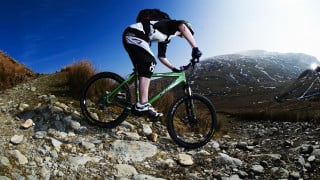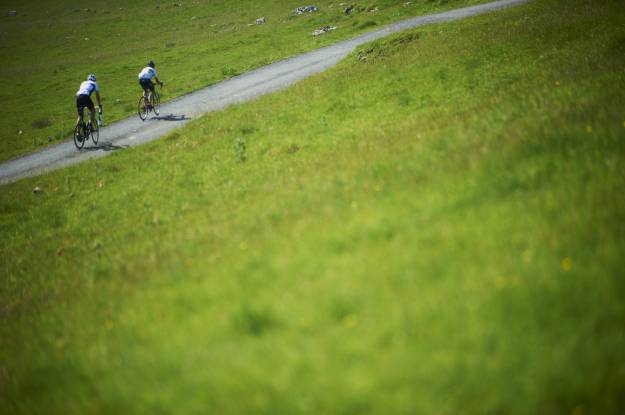Knowledge Level: Intermediate
Whether you are riding at a trail centre or exploring the countryside on by-ways and bridleways, you should always aim to be self-sufficient, have the equipment and knowledge to deal with mechanical issues and other mishaps. Make sure you have the following in your backpack.
Phone
Always have a fully charged mobile phone with you and make sure you’re not draining its battery by using its GPS for navigation or recording ride stats. Keep your phone in a fully waterproof case and protect it in the middle of your bag where it won’t be damaged in a fall. Register your mobile to be able to text message the emergency services as, in remote areas, there sometimes won’t be a strong enough signal to make a call but a text will often go. Have an I.C.E (in case of emergency) stored in your phone and make sure the security lock is turned off.
Spares and repairs
Carry a couple of spare inner tubes, even if riding tubeless, and also some quick stick puncture repair patches just in case you’re unlucky enough to have multiple flats.
A power link allows you to rejoin a broken chain without having to push pins back in. There are a number of different ones, such as SRAM Powerlink and KMC Missing Link, so check you’ve got the right one. These can be a genuine ride saver if you snap your chain. Have a practice at home first as some are easier to use than others and may require a specialist tool to operate.
Rear derailleur strikes are an inevitable part of mountain biking and, because of this, your rear mech is attached to the frame with a sacrificial hanger. Swapping a new one in is an easy trailside repair so it’s definitely worth sourcing a spare one. Make sure you get the right one for your make and model of bike. If in doubt, check with your local bike shop.
An emergency tyre boot allows you to patch up a damaged sidewall so that you can at least get home or back to your car. Buy a specifically designed one or an old toothpaste tube cut into sections works just as well.
Not strictly a spare but a selection of cable ties are incredibly useful to have and can facilitate many ‘get you home’ repairs.
Tools
A quality multi-tool that includes a chain tool will allow you to cope with most trailside repairs. You should also have some basic mechanical knowledge, such as indexing your rear derailleur and adjusting your front mech.
A pump is essential for re-inflating your tyres after a puncture. CO2 inflators are quicker but can mis-fire, you might run out of canisters and tyres often need topping up. A combined mini-pump and CO2 inflator is the ideal solution or just carry both. Before you even think about pumping though, you’ll need to get the tube out, so, don’t forget your tyre levers, if you use them, for your wheel and tyre combination. If you’re riding tubeless, you may also need some pliers to remove the valve core. These will also come in useful if you need to remove a thorn from your tyre.
Clothing
Even if you set out in warm weather, it can rapidly change and, if you have to stop for any reason, it’s very easy to become chilled. A waterproof should always be carried but a packable warm jacket or an extra base layer in a zip-lock bag are also sensible to have. A warm hat and some thick gloves are good to have for emergencies on winter rides.
Food and Drink
Make sure you have enough food and drink for your entire ride. It’s also sensible to have a small bag of emergency rations that you always leave in your backpack in case a ride goes on longer than expected. The Great Britain Cycling Team nutritionists, gives their advice on fuelling long bike rides.
Map
It’s far too easy to become overly reliant on GPS devices and trail centre way-markers. Carry a map of the area you’re riding in as it’ll allow you to plot a bail-out if you need to shorten a ride, find the trail if you miss an arrow and to always know exactly where you are at any time. You should also carry a compass and know how to use it.
First Aid Kit
A basic first aid kit and the knowledge of how to use it should be a priority for all mountain bikers. There are a number of compact and lightweight pre-packed kits available that are specifically aimed at outdoors use. A number of first aid courses are specifically tailored towards outdoors and adventure activities. If you ride regularly, you should seriously consider attending one.
A lightweight foil survival blanket weighs practically nothing, takes up hardly any room in your pack but could make all the difference in cold conditions.
ID
Especially important if you’re riding on your own and as a backup to the ICE stored in your phone. Wear an ID bracelet, dog-tag or some rucksacks have tags for you to write on. Basic information such your name, emergency contact and any important medical details will be invaluable for the emergency services.
Lights
A puncture, mechanical problem or navigational error and you can easily find yourself unexpectedly caught out after dark. A compact light or headtorch will get you back to civilisation or, if you have some road sections to ride, with a clip-on red rear light, ensure you’re safe and legal.
Money
Many remote areas with poor mobile phone coverage still have coin operated pay phones so, always carry some change. Some cash can also be useful for re-supplying with food and drink from small rural shops which may not accept debit cards.
Dry Bag
When riding in the UK it always has potential to rain, so ensuring your kit is kept dry is essential. There are many different types of waterproof bags available to line your rucksack with. Whichever you choose, make sure you treat it well and be careful of making a hole in the fabric, as it can be delicate.
Pre-Ride Checklist
You may find it useful to make a copy of the list below and double check it before every ride:
- Phone
- Inner tubes
- Puncture repair patches or kit
- Emergency tyre boot
- Power link + link tool if necessary
- Spare rear mech hanger
- Zip ties
- Pump or mini pump if travelling lightweight and CO2 inflator
- Multi-tool with chain tool
- Tyre levers
- Pliers
- Spare clothing (conditions dependent but a minimum of a waterproof)
- Food and drink (to last for the length of the ride + emergency rations)
- Map + compass
- Appropriately stocked First Aid kit
- Lightweight survival blanket
- ID
- Lights (including red rear if going on the roads)
- Money
- Dry bag










